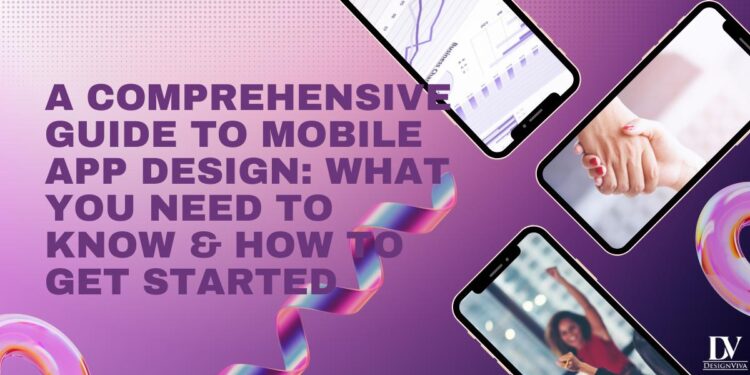Crafting an engaging mobile app design is no easy task. It involves strategically combining the right UX/UX elements, understanding user behavior, and selecting the most suitable technologies. In this comprehensive guide, we will discuss all of the essential concepts you need to know in order to create an effective and successful mobile app design. From understanding user requirements to selecting colors and typography, we’ll cover everything that you need to know in order to get started on your project.
Unlocking the Power of Mobile App Design
Mobile app design is a powerful tool that can be used to create amazing user experiences. It combines the art of user experience design with the technical aspects of mobile user interface design to create apps that are intuitive, attractive, and easy to use. When you want to design a powerful and exciting mobile user experience, contact an app design company in California, Designviva.
By taking advantage of mobile app design, companies can make sure their users have a great experience while using their products. This involves considering how people interact with an app on their devices and how they expect it to function. This can include everything from ensuring the screen size is appropriate for each device type to designing an intuitive navigation system that lets people easily find what they need.
By unlocking the power of mobile app design, companies can create amazing experiences for their users and ensure that their products stand out from the competition.
Mobile app design plays a critical role in the success of any mobile application. Here are some key elements to consider when designing a mobile app:
- User Experience (UX): The user experience is the most important aspect of mobile app design. You need to design an app that is easy to use, intuitive and provides a seamless experience for the user. Focus on designing an app that aligns with the user’s needs and goals.
- Visual Design: The visual design of your mobile app should be attractive, modern, and aligned with your brand identity. Use color schemes, typography, and iconography that are consistent with your brand and make your app visually appealing.
- Navigation: Navigation is key to a successful mobile app design. Make sure your app’s navigation is clear, simple, and intuitive, so users can easily find what they’re looking for.
- Performance: Your app should be optimized for performance, speed, and functionality. Make sure it loads quickly, runs smoothly, and doesn’t crash or freeze.
- Personalization: Personalization is an essential part of mobile app design. Design your app to provide personalized experiences for users, such as tailored content, recommendations, or push notifications based on their preferences and behavior.
- Security: Security is critical for any mobile app that deals with sensitive user data. Design your app to be secure, with strong authentication and encryption measures in place to protect user data.
- Testing and Feedback: Finally, it’s important to test your app thoroughly and get feedback from users. Conduct usability tests, and beta testing, and gather feedback from users to identify any issues or areas for improvement.
By considering these elements in your mobile app design, you can unlock the power of mobile apps and create a successful app that engages users and delivers value.
The Essentials of Good Mobile App Design for Maximum Engagement
Mobile apps have become a vital part of modern people’s lives. From shopping to entertainment, mobile apps are a convenient way for customers to engage with brands and services. This means that having a good mobile app design is essential if you want to maximize engagement with your users.
Good mobile app design should focus on the user experience (UX). UX designers must take into account factors such as user needs, usability, accessibility, and design trends when creating an app. It should also consider the layout and functionality of the app in order to create an intuitive flow that makes the user’s experience enjoyable.
By following UX best practices and staying up-to-date with mobile design trends, you can ensure that your mobile app has maximum engagement potential.
Good mobile app design is essential for maximum engagement with your audience. Here are some key essentials of good mobile app design:
- Simplicity: Keep your app design simple, intuitive, and easy to navigate. Avoid clutter and focus on providing a clean and straightforward user interface.
- Consistency: Maintain consistency throughout your app design, including color schemes, typography, and iconography. This will help create a cohesive and memorable brand identity.
- Accessibility: Design your app to be accessible to all users, including those with disabilities. Use clear and legible fonts, color contrast, and provide alternative text for images.
- Performance: Optimize your app for performance and speed. Users expect apps to load quickly, run smoothly, and not crash or freeze.
- Personalization: Personalize your app to provide tailored experiences for your users. Use data to customize content, recommendations, or push notifications based on user behavior.
- Feedback: Provide users with the ability to provide feedback on your app. This can help you identify any issues or areas for improvement and enhance the user experience.
- Security: Ensure your app is secure and protect user data by implementing strong authentication and encryption measures.
- Visuals: Use visuals to create an engaging user experience. This includes high-quality images, videos, and animations.
- Usability Testing: Conduct usability testing to identify any issues with your app design and make necessary improvements. This will help ensure your app is easy to use and meets user needs.
By following these essentials of good mobile app design, you can create an app that engages and delights your audience, while also providing value and enhancing the user experience.
Understanding Responsive Design & Adaptive User Interfaces
Responsive design and adaptive user interfaces are two design techniques that are used to optimize websites and applications for different devices and screen sizes.
Responsive design is a design technique that allows a website or application to automatically adjust to different screen sizes and device types. With responsive design, the layout and content of the website or application will change based on the size of the screen, providing users with an optimal viewing experience regardless of the device they are using. Responsive web design is a technique that uses a combination of flexible grids, images, and CSS media queries to improve the user experience on any device.
Adaptive user interfaces, on the other hand, are designed to adjust to the specific device being used by the user. An adaptive user interface will detect the user’s device and adjust the layout and content accordingly. This can provide a more tailored experience for users based on the specific capabilities and limitations of their devices. Adaptive user interfaces use device detection, which identifies the device being used and adapts the design to fit the device’s screen size, resolution, and orientation.
While responsive design and adaptive user interfaces share some similarities, they are different in terms of their approach and implementation. The responsive design focuses on creating a flexible design that can adjust to different screen sizes, while adaptive user interfaces focus on tailoring the design to fit the specific device being used by the user. Both approaches have their advantages and disadvantages, and the choice between responsive design and adaptive user interfaces will depend on the specific needs and goals of your website or application.
How to Create Engaging User Interfaces Using Visual & Interaction Elements
Creating engaging user interfaces using visual and interactive elements is essential for providing an enjoyable user experience. Here are some tips to help you design visually appealing and engaging user interfaces:
- Use color effectively: Choose a color scheme that reflects your brand and helps to create a clear visual hierarchy. Use color to highlight important elements, create contrast, and guide the user’s attention.
- Use typography strategically: Choose fonts that are easy to read and complement your brand’s aesthetic. Use typography to create a clear hierarchy and emphasize important information.
- Use icons and images: Use icons and images to visually represent information and make the interface more engaging. Use high-quality images and icons that match your brand’s aesthetic and style.
- Create clear navigation: Ensure that the user can easily navigate through the interface. Use clear labels and intuitive navigation elements to help the user find what they are looking for.
- Use animation: Use animation to make the interface more engaging and provide visual feedback to the user. Use animation to highlight important elements, transitions between screens, and indicate progress.
- Create responsive design: Design your interface to be responsive and adjust to different screen sizes and devices. Use responsive design to ensure that the user can access the interface on any device.
- Focus on accessibility: Ensure that the interface is accessible to all users, including those with disabilities. Use color contrast, alternative text for images, and clear typography to make the interface easier to use.
By using these tips to create visually appealing and engaging user interfaces, you can enhance the user experience and create a more successful product. Remember to test your designs with users to get feedback and make necessary improvements.
Modern UI/UX Principles for Developing a Successful Mobile App
Developing a successful mobile app requires an understanding of modern UI/UX principles. Here are some principles to keep in mind when designing a mobile app:
- Simple and intuitive design: The app should have a simple and intuitive design that makes it easy for users to navigate and understand its features. Use clear typography, simple iconography, and consistent color schemes to create a cohesive visual language.
- Focus on user needs: The app should be designed with the user in mind. Consider user needs and behaviors when designing features and interactions.
- Create a clear and consistent visual hierarchy: Use a clear visual hierarchy to guide the user through the app. Use size, color, and contrast to create a clear visual hierarchy that emphasizes the most important elements.
- Use animations and transitions to enhance the user experience: Use animations and transitions to provide visual feedback to the user and enhance the overall user experience. Use animations to provide feedback on user interactions, indicate loading, and transitions between screens.
- Design for different devices and screen sizes: Ensure that the app is designed to work on a variety of different devices and screen sizes. Use responsive design to ensure that the app is optimized for different screen sizes and orientations.
- Use familiar and recognizable UI patterns: Use familiar UI patterns to make it easy for users to understand how to interact with the app. Use standard UI patterns for navigation, buttons, and interactions to create a familiar experience for users.
- Test and iterate: Test the app with users to get feedback on the design and make necessary improvements. Iterate on the design based on user feedback to create a better user experience.
By following these UI/UX principles, you can create a mobile app that is easy to use, visually appealing, and engaging for users.
Essential Tools & Resources for Professional Mobile App Designers
Professional mobile app designers use a variety of tools and resources to create high-quality designs. Designviva offers the best mobile app design tools and resources to create high-quality designs. Here are some essential tools and resources for professional mobile app designers:
- Sketch: Sketch is a popular vector design tool used by many professional designers. It allows you to create and edit high-quality designs for mobile apps.
- Adobe Creative Suite: Adobe Creative Suite includes a range of tools that are useful for mobile app designers, including Photoshop, Illustrator, and XD. These tools are helpful for creating high-quality graphics and designing app interfaces.
- Figma: Figma is a cloud-based design tool that allows designers to collaborate and share their designs with team members. It includes a range of features that are useful for designing mobile app interfaces.
- InVision: An inVision is a prototyping tool that allows designers to create interactive prototypes of mobile app interfaces. It’s helpful for testing app designs and getting feedback from users.
- Material Design: Material Design is a design system created by Google that provides guidelines and resources for designing mobile app interfaces. It includes templates, icons, and other design elements that can be used to create high-quality mobile app designs.
- iOS Human Interface Guidelines: The iOS Human Interface Guidelines are a set of guidelines and resources provided by Apple for designing mobile app interfaces for iOS devices. These guidelines are helpful for designing interfaces that are optimized for iOS devices.
- Android Material Design Guidelines: The Android Material Design Guidelines are a set of guidelines and resources provided by Google for designing mobile app interfaces for Android devices. These guidelines are helpful for designing interfaces that are optimized for Android devices.
By using these tools and resources, professional mobile app designers can create high-quality designs that are optimized for mobile devices and provide an enjoyable user experience.







